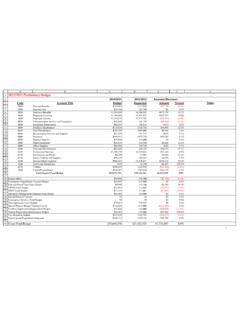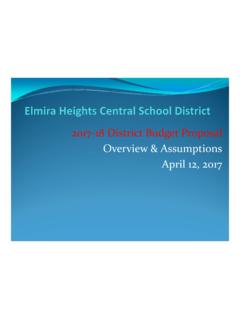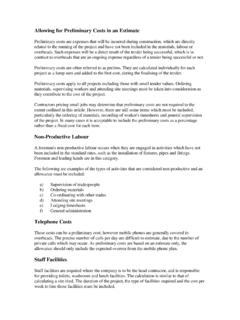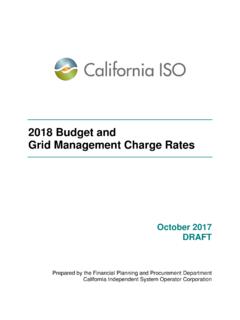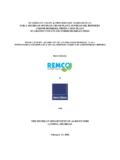Transcription of Testimony of Vincent Sapienza, P.E. Acting …
1 Testimony of Vincent Sapienza, Acting Commissioner, New york city Department of Environmental Protection before the New york city Council Committee on Environmental Protection concerning the FY 2018 Preliminary Budget Committee Room city Hall Thursday, March 23, 2017, 10:00 am Good morning Chairman Constantinides and Members. I am Vincent Sapienza, Acting Commissioner of the New york city Department of Environmental Protection (DEP). I am joined today by Chief Financial Officer Joseph Murin, Deputy Commissioner for Public Affairs Eric Landau, as well as other senior managers.
2 Thank you for the opportunity to testify on DEP's Fiscal Year 2018 Preliminary Budget. As you very well know, DEP has overall responsibility for the city 's water supply and sewer system, including providing drinking water to all New Yorkers, maintaining pressure to fire hydrants, managing storm water, and collecting and treating wastewater. In addition, DEP also regulates air quality, hazardous waste, and critical quality of life issues, including noise. All of our water-related expenses both operational and capital are paid for with the money collected from the water and sewer rate charge billed to all New york city property owners and authorized annually by the New york city Water Board.
3 In May 2016, the NYC Water Board adopted a rate package that included: - increase, the lowest increase in 16 years - freezing of the minimum charge of $ per day for the third consecutive year, which benefits more than 150,000 customers who use fewer than 100 gallons of water per day - expanding of the Home Water Assistance Program to any property owner who makes less than $50,000 per year, providing a $118 credit - creating the Multi-family Affordable Housing Credit, which would provide a $250 credit to any residential property that signs, at a minimum.
4 A fifteen-year affordability agreement with NYC Housing Preservation and Development or the NYC Housing Development Corporation Additionally, as part of last year's budget, Mayor de Blasio fully eliminated the rental payment, five years sooner than originally projected. As part of the FY 17 Water Rate, the NYC Water Board adopted a one-time credit of $183 to all Tax Class 1 properties, which includes 1-, 2-, and 3-family homeowners. As you all know, the FY 17 Water Rate and $183 credit were challenged by the Rent Stabilization Association.
5 Based on an original ruling from the NYS Supreme Court, as well as a subsequent ruling from the Appellate Division, First Department, we are currently unable to implement the FY 17 rate, associated program expansions, and the $183 credit. The Water Board is seeking leave to appeal this decision, and we will be sure to keep you all apprised of that process. The Water Board is also in the process of determining how it will proceed this spring with setting rates for FY 2018 and we will be sure to keep you updated. Before I get to the substance of my Testimony today, I want to briefly touch on the quality of New york city 's drinking water.
6 Water quality in Flint, Michigan, Hoosick Falls, and Newburgh continue to be covered widely in the news. Much has been made of late about elevated lead levels in some NYC school fixtures (fountains, sinks, etc.). I want all New Yorkers to rest assured that New york city 's drinking water is of the highest quality and the water delivered from the upstate reservoir system is lead free. We spend substantial time and resources testing the water quality from 1,000 water quality testing locations around the five boroughs, as well as testing water quality upstate in our reservoirs, lakes, and tunnels.
7 In total, DEP conducts over 600,000 water quality tests every year. The Department of Education is currently completing citywide testing of all water fixtures in city schools. Any drinking or cooking water fixture with results over 15 parts per billion is immediately taken offline and remediated. Again, while New york city 's water is lead-free when it is delivered from our reservoir system, water can absorb lead from pipes, fixtures, and solder (material used to join pipes) found in the plumbing of some buildings or homes.
8 To help reduce the risk that lead can dissolve from a homeowner's plumbing/service line into their tap water, DEP carefully monitors pH levels (a measure of acidity/alkalinity) of the water and adds phosphoric acid, which creates a protective film, reducing the release of metals from household plumbing. Property owners interested in testing their water for lead can contact DEP for a free lead kit by calling 311. Upon receiving the water sample, DEP will test the water and send the property owner the results within 30 days.
9 Should the results show an elevated level, DEP shares the results with the Department of Health and Mental Hygiene, and the city will inform the property owner of some recommended next steps. Key Accomplishments and Updates Let me start by providing some context to our capital and expense budgets, including some recent accomplishments, updates on our initiatives as part of OneNYC, a brief overview of a number of performance metrics, and an update on key programs and projects. This past year we: - completed a $1 billion project to upgrade four wastewater treatment plants and reduce nitrogen discharges into local harbor waterways by 60%.
10 - completed construction and activated a $260 million water tunnel connecting Brooklyn and Staten Island, creating additional redundancy - began a $132 million sewer upgrade project in College Point, Queens, to mitigate street flooding and improve harbor water quality of Flushing Bay - began a $34 million dredging project in Flushing Bay - began a $ million project in Canarsie, Brooklyn, to reduce flooding and upgrade water mains 2. - opened an additional 2,600 acres for recreation in the watershed more than 133,000 acres are now open for fishing, hiking and other low-impact recreation - reauthorized the lien sale with the strong support of the city Council, the Department of Finance, and Housing Preservation & Development, providing DEP the ability to sell liens on delinquent water rate payers, ensuring that everyone who benefits from our water and wastewater systems pays their fair share.










